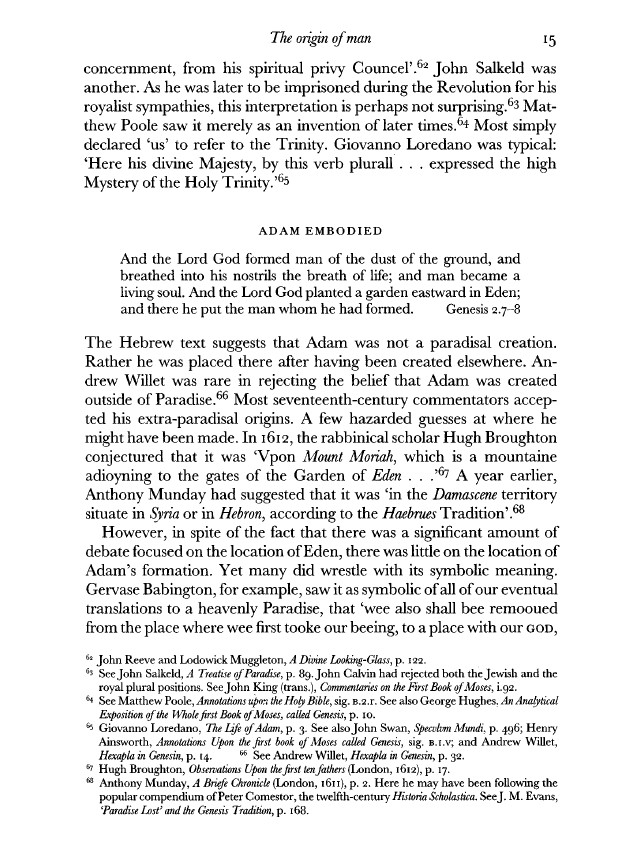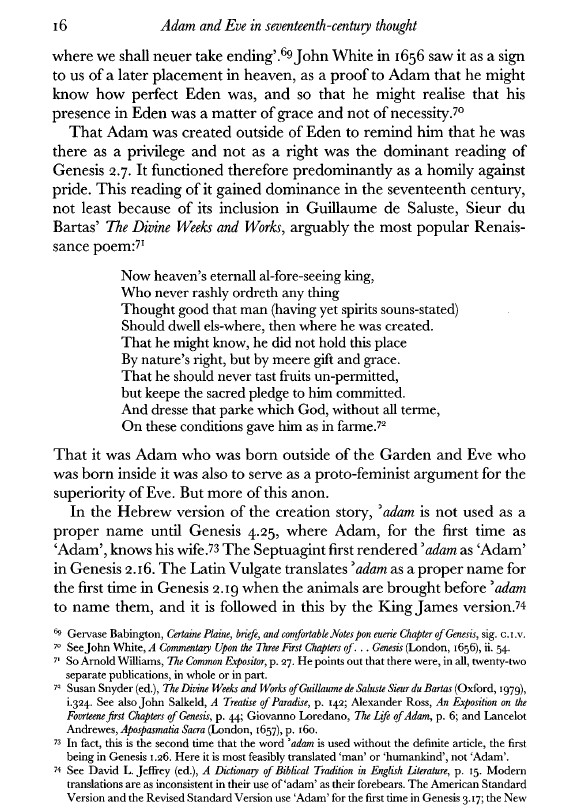Philip C. Almond notes how interpreters in the 17th-century believed that Adam was created before being placed in the Garden of Eden.
- Type
- Book
- Source
- Philip C. Almond Non-LDS
- Hearsay
- DirectSecondary
- Reference
Philip C. Almond, Adam and Eve in Seventh-Century Thought (Cambridge: Cambridge University Press, 1999), 15-16
- Scribe/Publisher
- Cambridge University Press
- People
- Philip C. Almond
- Audience
- Reading Public
- Transcription
ADAM EMBODIED
And the Lord God formed man of the dust of the ground, and breathed into his nostrils the breath of life; and man became a living soul. And the Lord God planted a garden eastward in Eden; and there he put the man whom he had formed. Genesis 2.7-8
The Hebrew text suggests that Adam was not a paradisal creation. rather he was placed there after having been created elsewhere. Andrew Willet was rare in rejecting the belief that Adam was created outside of Paradise. Most seventeenth-century commentators accepted his extra-paradisal origins. A few hazarded guesses at where he might have been made. In 1612, the rabbinical scholar Hugh Broughton conjectured that it was 'Vpon Mount Moriah, which is a mountaine adioyning to the gates of the Garden of Eden . . .' A year earlier, Anthony Munday had suggested that it was 'in the Damascene territory situate in Syria or in Hebron, according to the Haebrues Tradition'.
However, in spite of the fact that there was a significant amount of debate focused on the location of Eden, there was little on the location of Adam's formation. Yet many did wrestle with its symbolic meaning. Gervase Babington, for example, saw it as symbolic of all of our eventual translations to a heavenly Paradise, that 'wee also shall bee remooued from the place where wee first tooke our beeing, to a place with our GOD, where we shall neuer take ending'. John White in 1656 saw it as a sign to us of a later placement in heaven, as a proof to Adam that he might know how perfect Eden was, and so that he might realise that his presence in Eden was a matter of grace and not of necessity.
That Adam was created outside of Eden to remind him that he was there as a privilege and not as a right was the dominant reading of Genesis 2.7. It functioned therefore predominantly as a homily against pride. This reading of it gained dominance in the seventeeth century, not least because of its inclusion in Guillaum de Saluste, Sieur du Bartas' The Divine Weeks and Works, arguably the most popular Renaissance poem:
Now heaven's eternall al-fore-seeing king,
Who never rashly ordreth any thing
Thought good that man (having yet spirits souns-stated)
Should dwell els-where, then where he was created.
That he might know, he did not hold this place
By nature's right, but by meere gift and grace.
That he should never tast fruits un-permitted,
but keepe the sacred pledge to him committed.
And dresse that parke which God, without all terme,
On these conditions gave him as in farme.
That it was Adam who was born outside of the Garden and Eve who was born inside it was also to serve as a proto-feminist argument for the superiority of Eve. But more of this anon.
- Citations in Mormonr Qnas
The B. H. Roberts Foundation is not owned by, operated by, or affiliated with the Church of Jesus Christ of Latter-day Saints.


